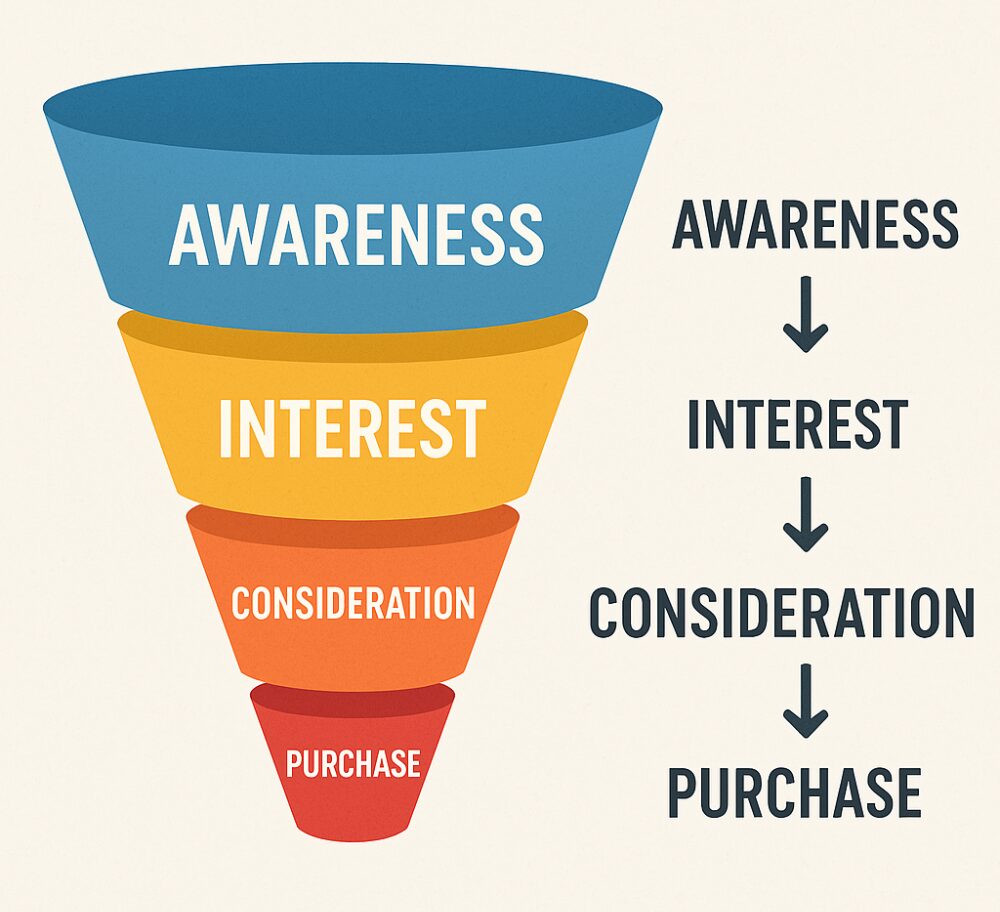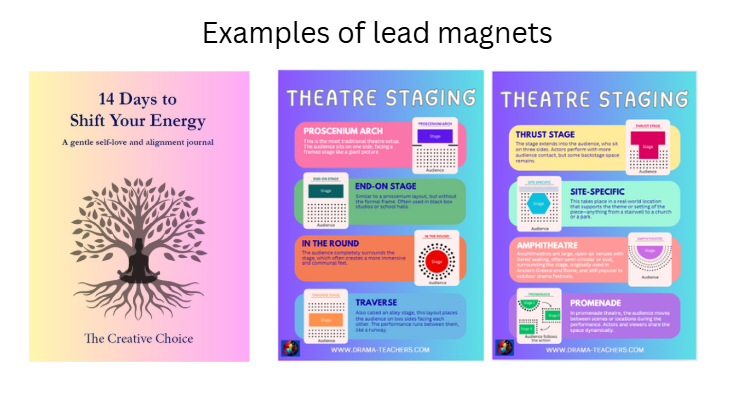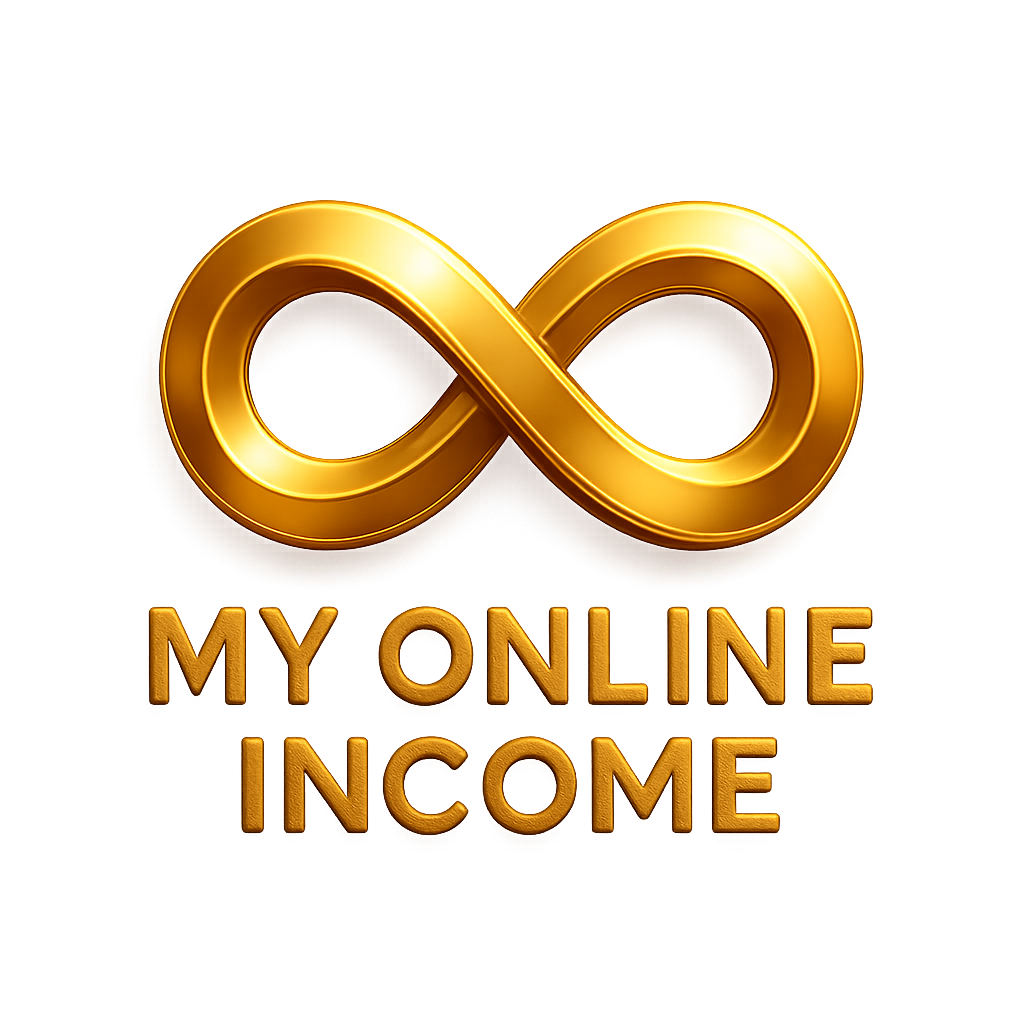If you’ve ever heard the term “marketing funnel” and immediately pictured pipes, pressure, or something involving a wrench, you’re not alone. While it might sound technical, the concept is actually simple: a marketing funnel is just the journey someone takes from discovering you to becoming a customer. Most people who land at your site are not here to buy from you… YET! There is a process to go through – like going on a date – it takes time to decide if that’s the person you want to marry! It’s the same with a stranger becoming a customer on your site, and even better, a returning customer on your site. It takes trust, and in today’s online world, that is not always easy to come by. That’s why you need to know how to build a beginner marketing funnel.
In this guide, we’ll break marketing funnels down step by step – no jargon, no overwhelm – just a practical way to build your first funnel and start generating income online.
So, what is a marketing funnel?
As we said, imagine trying to sell something to a complete stranger the first time they land on your website. Awkward, right?
That’s where a funnel comes in. It helps build trust gradually. Most funnels have three main stages:
- Top of Funnel (TOFU): Attract people who don’t know you yet
- Middle of Funnel (MOFU): Nurture the relationship with helpful content and insight
- Bottom of Funnel (BOFU): Make your offer and turn them into paying customers
In the dating analogy, it’s the equivalent of getting to know the person first, building a connection, and eventually seeing if it’s a good fit.
Some models break the funnel into four stages – Awareness, Interest, Consideration, and Purchase – which overlap like this:
- TOFU = Awareness
- MOFU = Interest and Consideration
- BOFU = Purchase
The terminology can vary, but the concept is the same: guide your audience from discovery to decision.
 A simple visual showing the journey from stranger to customer in four key stages*.
A simple visual showing the journey from stranger to customer in four key stages*.
*Note: These four stages overlap with the TOFU, MOFU, and BOFU model used throughout this guide.*
Start with your end goal
Before you build anything, get clear on this question:
What do I want people to do?
- Buy a product?
- Join a course?
- Book a discovery call?
- Sign up to an email list?
Choose one clear goal for your first funnel. It keeps things aligned and avoids overwhelm.
Step 1: Attract Awareness – Top of Funnel (TOFU)
This is where people first discover you. The goal is simple: get their attention and offer something valuable enough for them to stick around.
Ways to attract your audience:
- Blog posts with helpful tips (SEO-friendly)
- Social media reels or stories
- Free downloads or checklists (aka lead magnets)
- Pinterest pins or Facebook ads
Lead magnet ideas for beginners:
- A short PDF checklist
- A free 5-day email challenge
- A discount code or coupon
🧡Remember: TOFU is all about giving before asking – value to the customer before you try to sell!
Read our article on “What is a lead magnet and how do I use it in my online business” here.

Step 2: Nurture Interest and Consideration – Middle of Funnel (MOFU)
Once someone joins your list or follows you, it’s time to build the relationship.
Here’s how:
- Send a welcome email series (3-5 short emails)
- Share personal stories or your journey
- Offer tips that relate to your product or service
- Use social proof (testimonials, reviews, case studies)
This is where trust is built. Show up consistently and offer real value.
Be human, be helpful, and be consistent.
Step 3: Convert to Purchaser – Bottom of Funnel (BOFU)
Now it’s time to ask for the sale – but gently. Think invitation, not pressure. Just put yourself in their shoes – do you like pushy sales talk, or over-the-top claims? Probably not. And if you are anything like me, you probably hate those adverts that go on forever without telling you what the product is or the price!
Your customers will be the same. That doesn’t mean not asking, because you need to ask at this point. But there’s a way to do it to get more conversions.
Make sure you:
- Have a clear call to action (CTA): “Click here to buy” or “Book now”
- Remove friction: Keep your checkout or booking process smooth
- Use urgency wisely: bonuses, deadlines, or limited spaces – we’ve all see those countdowns that mean nothing or “limited offer discounts” that appear regardless of how many times you click on the site. Be honest – if there is a limited offer, make it limited and stick to it.
Tools that help here:
- ConvertKit for email delivery
- WooCommerce or ThriveCart for digital products
- Calendly for booking appointments

Tools that make funnel-building easier
If you’re worried about the tech part, don’t be. These tools are beginner-friendly:
- Canva – design graphics, lead magnets, and social posts
- Kit (formerly ConvertKit)or MailerLite – simple email automation
- Systeme.io or GrooveFunnels – all-in-one funnel platforms
- WordPress with Elementor – for drag-and-drop landing pages
You don’t need to use them all. Just start with one or two.
I use Canva to design things and Kit to host some landing pages and my email automation. I’ve been very happy with these, but I also have pages on my site that do the same thing as well.
Your beginner marketing funnel: what to build (and what to skip)
You don’t need a complicated 5-part funnel with upsells and tripwires right away.
Here’s a simple first funnel:
- Blog post or social content
- Lead magnet
- Email welcome sequence
- Product or service offer
That’s it. No bells and whistles. Just clean, clear, and consistent.
The ‘funnel’ part is really the YOU in the middle that links these altogether. Once you are happy with directing your clients through your virtual door, along you email content to the store at the end, you’ll see that marketing funnels are nothing to be scared of. They just gently direct your readers to the things they may (or may not) be interested in. But if they are interested in them, you’ve given them the perfect opportunity to buy from a trusted friend – and that’s YOU!
To conclude
Your first marketing funnel won’t be perfect – and that’s OK. The most important thing is to start. Build something simple, share your value, and tweak as you go.
✨ Consistency beats complexity. Always.
And remember: every online income success story started with just one funnel. Yours could be next. So don’t just sit on this article; get up and do something about it by building your first funnel. And then come back and let me know how it went in the comments below.
You can do it! And I’m cheering you on. To your success!

Related posts
Personal branding to build business trust and loyalty
Facebook and Instagram Reels and Stories: How to use them in business
How to use AI to build an online business

This was such a refreshing breakdown of marketing funnels. It felt like chatting with a savvy friend who genuinely wants to help! I especially liked how you tied it to dating; it makes the whole idea so much easier to grasp. The emphasis on building trust before selling is spot on and something I really believe in. Do you think video content is essential at any specific stage of the funnel, especially for beginners?
Hi Kavitha. Thanks for your kind comments and I’m so pleased that you felt like you were talking to a friend. We are all friends in this business. Even though lots of people talk about ‘competitors’, I like the term ‘potential collaborators’ better as we can all learn something from someone else. And helping others is really the end game of the best businesses, who realise that their job is to serve others, not satisfy their own needs. It’s really the secret to success.
To answer your question, I think that video is an important part and can be used effectively to reach more people, especially if you are using social media. You may find my article on “How to use Facebook and Instagram Stories and Reels in Business” useful here, as I think it will answer some of these questions for you. All the best, Gail.
Hi, this is incredibly valuable because it highlights the often overlooked heart of any successful marketing strategy building genuine relationships. The advice to share personal stories, provide consistent value, and use social proof resonates deeply in a digital world where trust is a currency. It’s refreshing to see a focus on being human rather than just being strategic. This phase is the true bridge between curiosity and conversion, and you explained it with clarity and empathy.
The reminder to “be helpful, be human, and be consistent” turns complex marketing theory into accessible action steps that even beginners can implement confidently. My question is what are some mistakes to avoid in a welcome email series during the MOFU stage?
Hi Ravin. Thanks for your kind comments and I’m so pleased that you agree that the heart of all successful marketing is cultivating relationships between real people – you and your client. It’s crucial if you want to build a business, a relationship or just live a happy life!
To answer your question, I think the main thing to avoid in the MOFU stage is to pressure your potential clients too early and forget the basics. You are still building the relationship and you need to add value so that they come to you rather than you having to drag them metaphorically ‘kicking and screaming’ into purchasing something from you.
You may like to read my article on “Common mistakes to avoid in affiliate marketing” as it lists quite a few things to avoid there.